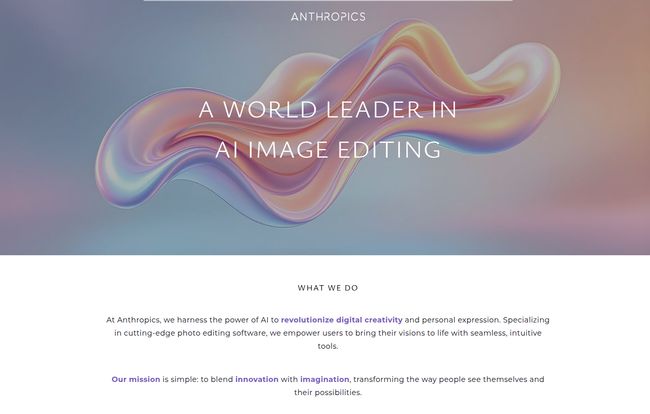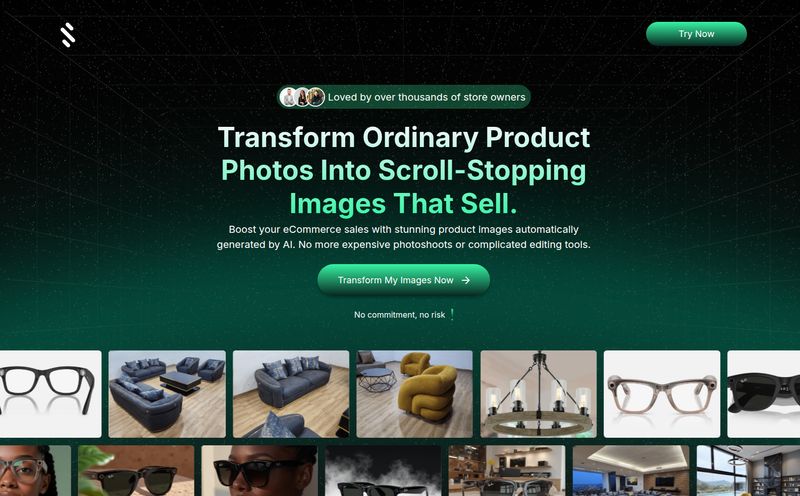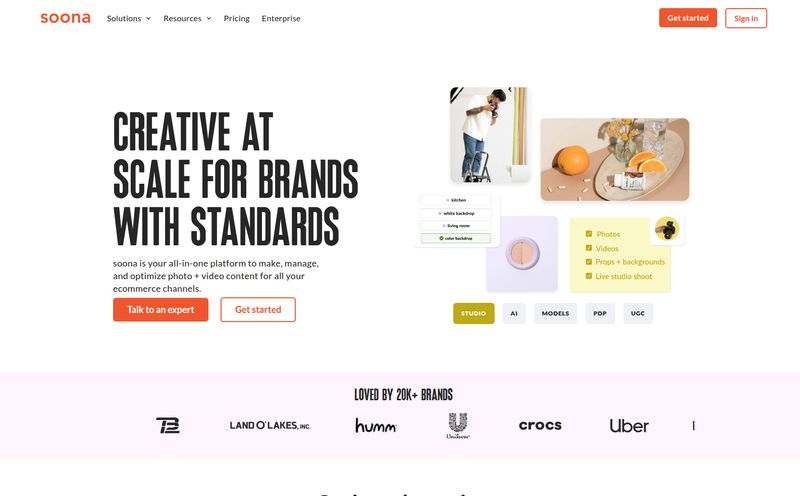I can still feel the phantom cramp in my hand from my early days as a photographer. Hours—no, days—spent in front of a monitor, meticulously cloning out blemishes, dodging and burning, and trying to make skin look like, well, skin. It’s a rite of passage, I guess. But honestly, it’s a grind. So whenever a tool comes along promising to do all that heavy lifting with the magic of “AI,” my inner cynic and my overworked optimist get into a fistfight.
Enter Anthropics Technology. You might not know the company name, but if you’ve been in the photography game for a while, you’ve definitely heard of their star player: PortraitPro. For years, it’s been the secret weapon in many a photographer’s toolkit. But Anthropics is more than just one piece of software. It’s a whole family of specialized AI-powered editors. I’ve been tinkering with their suite, and it's time to lay it all out there. Is it really a game-changer, or just another shiny object?
So, What Is This Anthropics Thing Anyway?
First off, these guys aren’t new to the scene. Anthropics was founded way back in 1998. In the tech world, that makes them practically ancient, and frankly, I find that reassuring. They’ve survived the dot-com bubble, the rise of social media, and the shift to mobile. They’re not some fly-by-night startup built on hype. They are a UK-based company that has been quietly perfecting AI-driven image manipulation for decades.
They don’t offer a single, do-it-all program like Photoshop. Instead, their strategy is to create highly specialized tools that do one thing exceptionally well. Think of them not as a general practitioner, but a team of surgeons, each with a specific focus: one for faces, one for bodies, and one for landscapes. It's an interesting approach in a market dominated by all-in-one solutions.

Visit Anthropics Technology
Breaking Down the Anthropics Toolkit
Let's take a quick walk through their product lineup. Each one targets a very specific pain point for photographers and creative professionals.
PortraitPro: The Famous One
This is their bread and butter. PortraitPro is probably the world's most well-known automated retouching software. You load a photo, and its AI gets to work identifying facial features with scary accuracy. From there, you can use sliders to smooth skin, enhance eyes, whiten teeth, sculpt the face, and even apply digital makeup. It’s incredibly powerful, and the results can range from subtly enhanced to… well, let's just say you can easily go too far if you're not careful.
PortraitPro Body and LandscapePro
Following the success of their portrait software, they expanded. PortraitPro Body does for full-body shots what PortraitPro does for faces. It’s a tool for reshaping and correcting posture, which is particularly useful in commercial and fashion photography. LandscapePro applies the same AI-first philosophy to outdoor shots. It can automatically detect sky, trees, grass, and water, allowing you to make dramatic changes—like swapping a bland, overcast sky for a brilliant sunset—with just a few clicks. It’s pretty wild to see in action.
The New Kids: Smart Photo Editor & Bridely
These show the company is still innovating. Smart Photo Editor has a unique community angle, letting users share and use editing effects created by other people. It’s a bit more playful. Bridely, on the other hand, is a serious B2B play, offering a virtual try-on experience for wedding dresses. This signals a clear move into the e-commerce solutions space, which is a smart move.
The Stuff I Actually Love About It
Alright, let's get to the good stuff. After using these tools, a few things really stand out. First and foremost is the AI-powered automation. The speed is just phenomenal. Tasks that used to take me 30-45 minutes of careful masking and brushing in Photoshop can be 80% done in under a minute. The AI isn't perfect, but it gets you so close to the finish line, so fast. It's like having a junior retoucher who does all the boring prep work for you.
Second, you can achieve genuinely professional-quality results. This isn't just slapping on a cheap filter. With a bit of restraint, you can produce edits that are clean, natural, and would pass the sniff test of most clients. The level of control, from specific skin pores to the iris of an eye, is impressive.
For me, though, the biggest win is the Photoshop integration. The Studio editions of their software can run as a Smart Filter directly inside Photoshop. This is a non-negotiable part of my workflow. It means I can apply the AI edits non-destructively on a layer, mask parts out, and blend it perfectly with my other adjustments. It’s the best of both worlds. And for the heavy-hitters like wedding or school photographers, the Studio Max edition’s batch processing is an absolute lifesaver. Imagine applying consistent, smart touch-ups to hundreds of photos at once. Yes please.
Okay, But It's Not Perfect. Let's Get Real.
I wouldn't be doing my job if I didn't point out the flaws. And there are a few things that bug me. Let's start with a pet peeve: their website's cookie consent manager can be… a lot. It’s a small thing, but it’s an annoying first impression.
More substantively, the price can be a hurdle. This isn’t a $9.99/month subscription. You typically buy the software outright, and the more advanced editions with the features you really want (like that Photoshop plugin) can feel a bit expensive. It's an investment.
Another thing is that it requires a download and install. In a world that's rapidly moving to the cloud and browser-based apps, having to download, install, and manage updates on your local machine feels a tad old-fashioned. The upside is you can work completely offline, but it's a trade-off.
Finally, there's the classic case of feature-gating. The most powerful tools, like batch processing or handling RAW files, are often reserved for the top-tier, most expensive editions. It's a common business practice, but it's always a little frustrating when you realize the one feature you need means shelling out more cash.
Who Should Actually Buy This Software?
So, who is this for? I've got a pretty clear idea.
- Professional Portrait Photographers: This is a no-brainer. The time you save on retouching just one or two shoots will likely pay for the software.
- Wedding & Event Photographers: If you're delivering hundreds of images, the batch processing in the Studio Max version of PortraitPro is worth its weight in gold.
- E-commerce Businesses: Especially those in fashion or beauty. Creating clean, consistent product shots of models is exactly what this is built for.
- Serious Hobbyists: If you're passionate about getting the best-looking portraits or landscapes and find Photoshop a bit intimidating, this is a fantastic, more guided alternative.
Who is it not for? Probably the casual smartphone shooter or the Instagrammer who is happy with a simple filter. This is a more powerful, nuanced tool that requires a bit of an investment in both money and learning.
What's the Damage? A Look at the Pricing
This is where it gets a little complicated, because there isn't one single price. Anthropics operates on a perpetual license model, meaning you buy the software once and own it for that version. They sell each product—PortraitPro, LandscapePro etc.—separately.
Each product then comes in different editions, typically something like:
- Standard: The basic, standalone version.
- Studio: Includes the crucial Photoshop/Lightroom plugin support and handles RAW files.
- Studio Max: All of the above, plus the full-power batch processing mode.
My advice? Go to their website. They run promotions and bundle deals all the time, so the list price is rarely what you end up paying. Check what features are in each edition and decide if the plugin or batch mode is essential for your work. For most pros, the Studio edition is the sweet spot.
My Final Verdict on Anthropics
After spending some quality time with the Anthropics suite, I'm walking away impressed, with caveats. This isn't a magical one-click fix that will make you a better photographer. Your lighting, posing, and composition still have to be solid. But what it is, is an incredibly effective efficiency tool. It’s a specialist.
It automates the most tedious 80% of post-processing work for portraits and landscapes, freeing you up to focus on the final 20%—the creative touches that define your style. For the right professional, the time saved isn’t just a convenience; it translates directly into more clients, faster turnaround, and a healthier bottom line. It's a sharp, powerful scalpel in a world of bulky multi-tools, and if your work demands that level of precision, it’s an investment that's hard to argue against.
Frequently Asked Questions
- Is Anthropics software a one-time purchase?
- Yes, for the most part. You buy a perpetual license for the current version (e.g., PortraitPro 23). When a major new version is released, you'll typically have to pay to upgrade, often at a discounted price.
- Can I use PortraitPro as a Photoshop plugin?
- Absolutely, but you need to buy the Studio or Studio Max editions. The Standard edition only works as a standalone application. This is a key difference to be aware of before purchasing.
- Is Anthropics software difficult to learn?
- The basics are incredibly easy, as the AI does most of the initial work. You can get good results in minutes. However, mastering the hundreds of sliders and fine-tuning controls to develop a consistent, natural style does take some practice.
- Is there a free trial available?
- Yes, Anthropics almost always offers a free trial for their software. I highly recommend downloading it to see if it fits your workflow and produces results you like before you commit to buying.
- Is using a tool like PortraitPro Body ethical?
- That’s a big question. Like any powerful tool, it can be used responsibly or irresponsibly. For subtle corrections in commercial photography, it can be a useful tool. However, the potential for creating unrealistic body standards is very real. As a creator, the responsibility falls on you to use it ethically and with restraint.
- What’s the main difference between the Standard and Studio editions?
- The biggest differences are that the Studio edition works as a plugin for programs like Adobe Photoshop and Lightroom, can handle RAW files, and supports different color spaces. For any serious or professional photographer, the Studio edition is usually the recommended choice.



